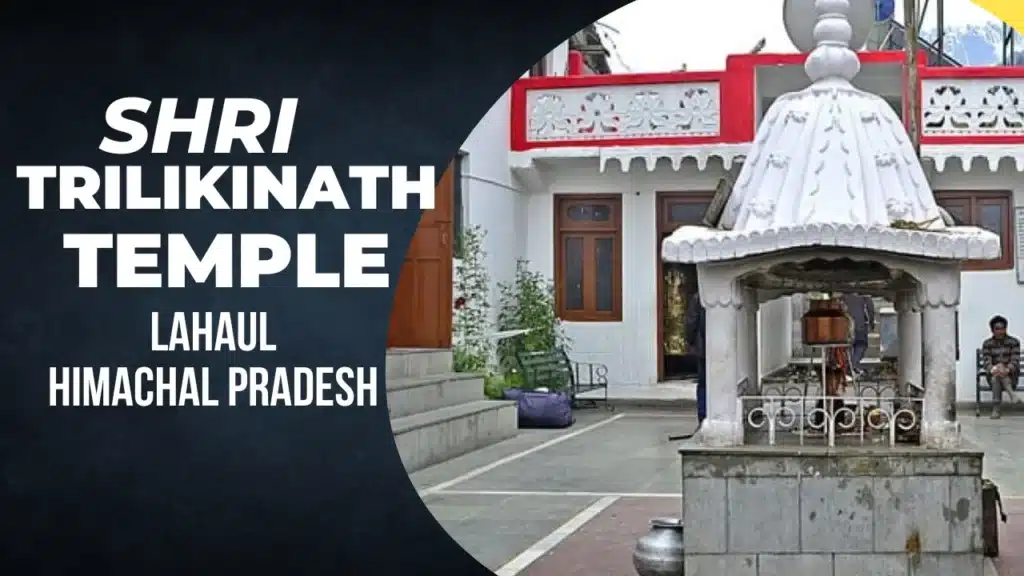Welcome to an enchanting journey through the stunning landscapes of Lahaul, Himachal Pradesh, where spirituality and the majestic beauty of the Himalayas come together. Our expedition leads us to the revered Trilokinath Temple, a sacred sanctuary located at the center of this peaceful region. In this informative guide, we explore the history, importance, architecture, and spiritual atmosphere of this impressive temple. Come with us as we uncover the mysteries of Trilokinath, a place where faith harmonizes with the breathtaking natural surroundings.
The Divine Abode of Trilokinath Temple
Tracing Historical Tapestry
The roots of Trilokinath Temple stretch back to the 10th century, a historical epoch substantiated by a stone inscription unearthed within the temple complex in 2002. According to this ancient inscription, the temple was a labor of devotion, constructed by the visionary Dvanjra Rana. This lineage is believed to be ancestral to the contemporary Rana Thakur rulers of Triloknath village. An intriguing twist to this historical tapestry reveals that King Shell Varman of Chamba, credited as the architect of the temple, designed it in the ‘Shikher style,’ reminiscent of the illustrious ‘Laxmi Narayan’ temple complex in Chamba. Notably, King Shell Varman held the distinction of founding Chamba town itself.

The construction of this awe-inspiring temple commenced towards the close of the 9th century, extending into the early 10th century. Adding to its lore, Rajgrana of Chamba and the venerated Mahayogi Sidh Charpati Dar, also known as Charpath Nath, played pivotal roles in its realization.
Spiritual Resonance
Trilokinath Temple finds its sanctity celebrated equally by Hindus and Buddhists alike. While Hindus revere the Triloknath deity as Lord Shiva, Buddhists pay homage to Trilokinath in the form of Avalokiteshwara. This architectural masterpiece is revered as one of the most sanctified spiritual havens in the region, attracting multitudes of devotees year after year. It stands beside the flowing Chandrabhagha river, believed to cleanse the souls of pilgrims and bestow the divine blessings of Lord Shiva. Here, seekers from distant corners congregate, seeking divine intervention, spiritual solace, and inner tranquility.
Architectural Elegance
The temple’s architectural grandeur is a sight to behold. Crafted predominantly from wood and stone, it harmoniously blends with the pristine Himalayan backdrop. The intricately carved façade and sculptures adorning the temple bear testimony to the remarkable craftsmanship of the local artisans. A multi-tiered pagoda-style roof imparts an aura of enchantment to the temple, rendering it a visual delight for all who visit.
Embarking on the Journey to Trilokinath
A Picturesque Drive
The odyssey to Trilokinath Temple itself is an adventure of its own. Commencing from the Tandi Pull (bridge), the route winds its way through the awe-inspiring vistas of Pattan valley. As you drive on this Tandi Kishtwar Highway, traversing the meandering roads, a mesmerizing tapestry unfolds, replete with streams, small rivers, even waterfalls and the majestic high towers of Himalayan mountains on both sides of the valley. Along the way, you’ll encounter several charming villages and towns, including Jhalma, Shansha, Kirting, Thirot and just before you reach a village called Arat, you leave the Tandi-Kishtwar Highway and turn left downwards towards Biyadi Bridge and onwards to Trilokinath. A notable mention is the Biyadi bridge, constructed by the late Sh Siri Ram of HPPWD in the late seventies. Prior to that, the only way to reach on the other side of the Chandrabagha river to reach Trilokinath was precarious Khishori Bridge, accessible by foot, and notorious for swaying wildly while crossing this bridge.
Spiritual Trekking
For those seeking a more adventurous path, a trekking route to Trilokinath awaits your exploration. Begin your journey by disembarking at either Arat or Chuling village, where you can engage in conversations with the friendly locals and gather valuable insights. Drawing from my personal experience, having embarked on this trek numerous times during my younger days, I can attest to its allure.
Chuling Village and Khishori Village
The trek commences from Chuling village, ultimately leading you to the renowned Kishori bridge, as previously mentioned. I hope this bridge has since received necessary upgrades or enhancements to ensure its sturdiness. Upon traversing this bridge, you will find yourself in the charming village of Kishori. This picturesque route will soak you in the natural beauty of Lahaul. The locals are mostly farmers who grow potatoes, peas and cabbage in their fields. Passing through the fields or villages, you can engage with the warm-hearted local people. Along the way, you’ll be treated to breathtaking vistas that are nothing short of awe-inspiring. As you ascend from Kishori village, be prepared for a relatively steep climb. However, once you reach the summit, where Trilokinath majestically perches atop a colossal cliff, you’ll be rewarded with an experience that will remain etched in your memory for a lifetime.
Celebrations and Festivals
Trilokinath Temple comes alive during various festivals, with the most notable being the annual Trilokinath Fair. During this festive season, the temple dons vibrant and ornate decorations, while the local populace gathers for joyous celebrations, characterized by dance, music, and religious rituals. It provides a unique opportunity to immerse oneself in the vibrant culture of Lahaul.
Pauri Mela
Each summer, in the third week of August, Lahaul is graced by a vibrant fair, once the grandest event in the region. People hailing from Lahaul, Chamba, and Kullu, regardless of their origins, converge for this exceptional blend of pilgrimage and festivity. Preparations commence a week ahead, and many arrive a day earlier for a glimpse of the revered Triloknath statue, embodying Shiva, Lord of Three Worlds, or Avolokiteshvara for Buddhists. After paying homage, they circumambulate the temple’s inner and outer walls, typically completing three or seven clockwise rounds, all the while spinning prayer wheels and chanting mantras like “OM MANI PADME HUM” during the mornings and evenings.
Tradition and Custom
Within the temple, lamps fueled by ghee and mustard oil burn ceaselessly, their upkeep dependent on donations. One remarkable lamp within the temple can hold up to 16 kilograms of ghee or oil. Post-rituals, the fair commences, featuring makeshift shops, tea stalls, and hotels that spring up across the fairground. As night descends, pilgrims come together for circular dances set to the tunes of folk songs, both devotional and celebratory.
Sat dhara or Sapt dhara Ritual
On the second day, a traditional procession unfolds, led by the Thakur of Triloknath atop an adorned horse. The procession heads to a place called satdhara (seven springs), where, according to legend, seven gods, including Trilokinath, once emerged from seven springs. This stands as the pinnacle ritual of the fair.
Many devotees and others accompany this procession, some treading the sacred path barefoot, their voices harmonizing with Bhajans, as they fervently pray to Lord Shiva. The trail leading to Satdhara spans roughly 10 kilometers, a challenging ascent tracing the banks of the Satdhara nala, originating from the majestic Satdhara peak. Walking this path is an enchanting experience; the fatigue of the journey is forgotten amidst the breathtaking natural beauty, drenched in an atmosphere of serenity. This route not only captivates pilgrims but also beckons adventurers and tourists alike. Upon reaching the hallowed grounds of Satdhara, many devotees take a dip in the icy purifying waters.
One cherished tradition etched in my memory involves a unique ritual where participants contribute an item from their personal possession (handkerchief, key chains, scarfs or anything), which is later returned to them. All these items are meticulously mixed, and two items are chosen at random. The individuals linked to these items become brothers or sisters, forming a web of spiritual siblinghood in the name of Lord Trilokinath. Many view this as a divine blessing.
Following this, the procession returns to the fairground for further festivities. The mela continues for another few days with cultural programs like folk dances, singing and much more.
Exploring Nearby Attractions
Lahaul, adorned with pristine natural beauty, offers a plethora of attractions for eager travelers. While Trilokinath graces the Lahaul region, there exist several other towns, villages, monasteries, and lakes worth exploring during your sojourn.
Koksar
Koksar (Khoksar) a petite town, lies about 15 kilometers from Sissu and 75 kilometers from Trilokinath Temple. Situated along the banks of the Chandra River, it is a haven for trekking enthusiasts. Before the Atal tunnel’s inauguration, Koksar held the distinction of being the first town one encountered when reaching the Lahaul valley via the Rohtang pass.
Sissu
Sissu is the first village or rather small town as soon as you exit the Atal tunnel and enter Lahoul valley. Distance from Sissu to Triloknath Ji is only 60 km. Sissu is famous for the temple of Raja Geypan. It is a practice followed by locals and everyone to pay obeisance to the deity while passing through Sissu. Besides the temple, there are many attractions in Sissu like the village, Sissu waterfall, Sissu Lake and Ghepan Lake.
Tandi
Tandi, a diminutive village situated around 35 kilometers from Trilokinath, marks the confluence of the Chandra and Bhaga rivers, giving rise to the Chandrabagha river. This river gathers its strength from various turbulent tributaries, such as the one at Thirot and Udaipur, before crossing into the Jammu and Kashmir region, where it transforms into the mighty Chenab river. Tandi serves as the crossroads, with two routes branching off – one toward Keylong and beyond to Ladakh, and the other toward Trilokinath, Udaipur, Doda, and Kishtwar in Jammu and Kashmir. This valley is known as Pattan valley. The trekkers among us may fondly recall a challenging journey undertaken on foot from Tandi to Trilokinath, a distance covered in a single day.
Keylong
Keylong serves as the district headquarters of Lahaul and Spiti and stands as the gateway to Ladakh. The distance between Keylong and Trilokinath is approximately 45 kilometers. The region’s dry and cold climate contrasts with abundant greenery, and Keylong boasts ancient monasteries renowned for their art and Buddhist heritage.
Udaipur
Udaipur lies at a convenient distance of 12 kilometers from Trilokinath temple, separated by the Chandrabagha river. Not to be confused with its more famous namesake in Rajasthan, this Udaipur is renowned for the Markula Devi temple, dedicated to goddess Kali. Legend attributes the temple’s origins to the Pandavas, with its interiors adorned by intricate wood carvings depicting scenes from Hindu epics. The temple’s origins are believed to date back to the 11th century.
Miyar Valley
The Miyar Valley, also known as Miyar Nala, stretches for 75 kilometers, extending from Udaipur to the majestic Kang La. Flowing from the Kang La glacier’s snout, the Miyar River winds for nearly 50 kilometers before merging with the Chenab River. The glacier itself extends an additional 24 kilometers, culminating at the lofty Kang La jot, standing tall at 5,468 meters. Beyond Kang La lies the enchanting Zanskar region of Ladakh.
Valley of Flowers Himachal Pradesh
Often referred to as the “Valley of Flowers,” the Miyar Valley remains pristine and untouched, much like Zanskar. The locals embrace Buddhist traditions while predominantly engaging in shepherding and farming. During the summer months, they cultivate crops such as peas, barley, and an array of vegetables. The Gaddi Shepherds from Chamba region, graze their flocks of sheep and goats in the high-altitude meadows until late summer. Miyar Nala is also a haven for trekking enthusiasts and climbers. Referred to as the “Yosemite of India” or the “Himalayas,” this region has enticed professional rock climbers to ascend uncharted peaks. Yet, there remain unexplored summits, shrouded in mystery, adding an air of adventure to this captivating landscape.
How to Reach Trilokinath Temple
By Air
The nearest airport to Trilokinath is Bhuntar airport in Kullu, approximately 150 kilometers away. From Bhuntar (Kullu), the journey to Trilokinath unfolds through a picturesque route, passing through Manali, Solang Valley, Sissu, Tandi, and eventually, Trilokinath.
By Train
For those traveling by train, the nearest railway station is Joginder Nagar Railway Station, connecting to Pathankot. Subsequently, a road trip awaits to reach Lahaul.
By Road
Trilokinath Temple is accessible by road, with Manali serving as the primary gateway. Manali enjoys robust road connectivity to major cities in North India. The journey from Manali to Trilokinath offers breathtaking vistas, tracing along the Manali-Leh Highway. Travelers departing from Delhi will find themselves covering approximately 560 kilometers to reach Manali, while the distance from Chandigarh to Manali by road spans approximately 300 kilometers. For those beginning their journey from Delhi, consider spending a day or two exploring the famous tourist destination of Manali. Thereafter, hire a taxi or board an HRTC bus to embark on the voyage to Trilokinath.
Distances and Travel Times
Here are some distances to be mindful of when planning your expedition to Trilokinath, with estimates derived from Google Maps:
- Manali to Atal Tunnel: 29 kilometers (Approximately 45 minutes)
- Manali to Rohtang Pass: 29 kilometers (All vehicular traffic is routed through Atal Tunnel)
- Manali to Sissu: 40 kilometers (Approximately 1.5 hours by car)
- Manali to Keylong via Tunnel: 70 kilometers (Approximately 2 hours)
Weather in Lahaul Spiti
When planning your pilgrimage to Trilokinath Temple, it’s paramount to consider the region’s climatic conditions. Lahaul experiences extreme cold during the winter months, with temperatures plummeting well below freezing. The ideal time to visit is during the summer season, spanning from May to September, when the climate is pleasant, and the landscape is adorned with vibrant blooms. To ensure a comfortable and enjoyable journey, pack adequate warm clothing, comfortable trekking gear, and allocate ample time to bask in the spiritual and natural splendor of this divine sanctuary.
In Closing
In conclusion, Trilokinath Temple, situated in the serene Lahaul Himachal Pradesh, transcends mere religious sanctity; it epitomizes a sacred communion between nature and spirituality. Enriched by its historical significance, architectural opulence, and the pristine beauty that cradles it, Trilokinath Temple deserves a prominent spot on every traveler’s itinerary. So, prepare your bags, embark on this enriching expedition, and bear witness to the mystical allure of Trilokinath for yourself.”
Recent Posts
- Camping at Chandertal Lake, Himachal Pradesh: A Complete Guide
- Exploring Keylong: Your Ultimate Travel Guide
- Delhi to Manali Bus Journey: A Traveller’s Guide
- Bhrigu Lake Trek: A Himalayan Adventure from Ahmedabad
- Hampta Pass Trek: A Journey from Ahmedabad to the Himalayas
- Gobind Sagar Lake
- Chamba, Himachal Pradesh: A Comprehensive Travel Guide











